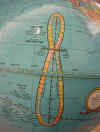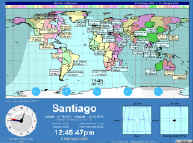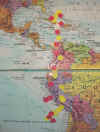|
Paper Plate Education
"Serving the Universe on a Paper
Plate"
Activity: Analemma Project

 With the Sub-Solar Cup activity
you can determine the position on the earth where an observer would see the sun
directly overhead. Plotting the sub-solar point at the same time each day
should yield an analemma, the figure-eight shape on a globe that expresses the
sun's declination and the equation of time. With the Sub-Solar Cup activity
you can determine the position on the earth where an observer would see the sun
directly overhead. Plotting the sub-solar point at the same time each day
should yield an analemma, the figure-eight shape on a globe that expresses the
sun's declination and the equation of time.
In this ongoing project, we hope to track the sub-solar
point for one year, provided the weather and personal commitments permit regular
observations at noon. See the Analemma
Project (same name, different project) for multiple exposure photographs that produce terrific visual image
of analemmas. Paper Plate Education, being a very casual pursuit,
will likely undertake this Sub-Solar Cup endeavor with less exactness.
Enjoy.
The results are in and appear at the
bottom of this page...
 From the Sun Clock home page at http://www.mapmaker.com/sunclock.htm
see the Sun Path diagram for depictions of analemmas. It is a nice addition
to this activity.
From the Sun Clock home page at http://www.mapmaker.com/sunclock.htm
see the Sun Path diagram for depictions of analemmas. It is a nice addition
to this activity.
 For continuity, we secure our globe in a base so our location (see figurine at
left) is atop the globe. Then we align our globe base with cracks in
a driveway that are nearly north-south. Any minor offset from north-south
will cause a slanted figure-eight.
For continuity, we secure our globe in a base so our location (see figurine at
left) is atop the globe. Then we align our globe base with cracks in
a driveway that are nearly north-south. Any minor offset from north-south
will cause a slanted figure-eight.

 Another way to check the north-south alignment is to track the path of the sun
through several hours. If the globe is properly aligned, the sun should
move along one latitude for the entire day.
Another way to check the north-south alignment is to track the path of the sun
through several hours. If the globe is properly aligned, the sun should
move along one latitude for the entire day.
At the end of 12 months we will mark the globe to clarify the path of
the analemma.


December 25, 2002
Noon (Standard Time) |
The sun appears just slightly above the Tropic of Cancer two days after
the December solstice. Please recognize the sub-solar image is an
approximate position, dependent on the accuracy of the globe's alignment
relative to the real earth. |


January 6, 2003
Noon |
For the first image, the base was wobbly on ice. The zoomed image
is with the base steady. Weather is mostly cloudy. |


January 9, 2003
Noon |
|

January 12, 2003
Noon |
|


January 22, 2003
Noon |
Hands shaky from bitter cold. Intermittent snow,
windy, temperature 10 degrees F. |



January 30, 2003
Noon |
|



February 11, 2003
Noon |
|


February 27, 2003
Noon |
Lesson learned: Do not align globe with intersection of four
slabs of concrete running along cardinal points, for when the slabs heave
in the winter the globe is not automatically level anymore. |


March 13, 2003
12:10 p.m. |
|

March 21, 2003
12:10 p.m. |
|

March 30, 2003
Noon |
|

April 15, 2003
Noon (Standard Time) |
An upside not to move the clock forward to daylight time
(DT): the time remains noon, Standard Time (ST). |

April 24, 2003
Noon |
|

April 29, 2003
Noon |
|

May 21, 2003
Noon |
|

June 17, 2003
Noon |
Has been a large gap since last observation. |




June 22, 2003 |
By tracking the summer solstice sun across the length of the
day, we can see the globe is slightly skewed from ideal. In the
morning the sub-solar point is slightly under the globe's Tropic of Cancer
line; in the afternoon the solar dot is well above the line. |

June 24, 2003
approx. noon |
|


July 9, 2003
Noon |
|

July 16, 2003
Noon |
|

July 25, 2003
Noon |
|

August 12, 2003
Noon |
|

August 19, 2003
12:05 p.m. |
|

August 28, 2003
Noon |
Meanwhile, Mars at opposition is making its closest approach
to earth in nearly 60,000 years. |

September 10, 2003
Noon |
|

September 15, 2003
Noon |
|

September 23, 2003
Noon |
September Equinox. The sun's position just above the
equator hints that the globe is slightly out of alignment. As long
as that error is kept nearly constant, we should still be able to plot a
figure-8 (albeit misaligned) onto the globe at the end of one year. |

October 12, 2003
Noon |
|

October 27, 2003
11:55 a.m. EST |
|

November 6, 2003
12:05 p.m. EST |
|

November 26, 2003
Noon |
 Meanwhile,
the big sunspot groups of 2003 come round again--a bonus while tracking
the sun. Meanwhile,
the big sunspot groups of 2003 come round again--a bonus while tracking
the sun.
Image courtesy of SOHO (ESA
& NASA).
|

December 2, 2003
Noon |
|

December 21, 2003
Noon |
 We're
done! We have tracked the sun for 12 months. Now we just have
to plot the points on the globe. To be more scientific about this,
we could continue tracking the sub-solar point to see if its path is
repeatable. You may notice that the sun does not exactly coincide
with the tropic of Capricorn. In the past year, the globe has
settled into the padded base and repeated handling has affected the
positioning of the base, globe, and cup. We're
done! We have tracked the sun for 12 months. Now we just have
to plot the points on the globe. To be more scientific about this,
we could continue tracking the sub-solar point to see if its path is
repeatable. You may notice that the sun does not exactly coincide
with the tropic of Capricorn. In the past year, the globe has
settled into the padded base and repeated handling has affected the
positioning of the base, globe, and cup. |
THE
OUTCOME
The
results are in, with mixed success. We first plotted the sub-solar point
with yellow circles on the Tropic of Capricorn and moved up to the Tropic of
Cancer. From there the red circles descend back to the Tropic of
Capricorn. If the three points immediately after the vernal equinox were
better positioned, then the figure-8 of the analemma would be more
apparent. Again, the globe was repositioned after each observation, so
plenty of error is introduced.
 globe-plot.jpg
(286 KB) globe-plot.jpg
(286 KB) |
 globe-plot2.jpg
(50 K globe-plot2.jpg
(50 K |
 globe-plotzoom.jpg
(275 KB) globe-plotzoom.jpg
(275 KB) |
 globe-plotzoom2.jpg
(34 KB) globe-plotzoom2.jpg
(34 KB) |
[Note:
The Sub-Solar Cup activity is detailed
in the Paper
Plate Astronomy video.]
|